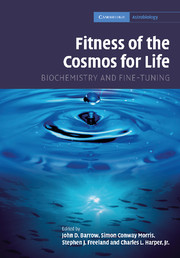Book contents
- Frontmatter
- Contents
- List of contributors
- Foreword: The improbability of life
- Preface
- Acknowledgments
- Part I The fitness of “fitness”: Henderson in context
- Part II The fitness of the cosmic environment
- Part III The fitness of the terrestrial environment
- Part IV The fitness of the chemical environment
- 16 Creating a perspective for comparing
- 17 Fine-tuning and interstellar chemistry
- 18 Framing the question of fine-tuning for intermediary metabolism
- 19 Coarse-tuning in the origin of life?
- 20 Plausible lipid-like peptides: prebiotic molecular self-assembly in water
- 21 Evolution revisited by inorganic chemists
- Index
- References
17 - Fine-tuning and interstellar chemistry
Published online by Cambridge University Press: 18 December 2009
- Frontmatter
- Contents
- List of contributors
- Foreword: The improbability of life
- Preface
- Acknowledgments
- Part I The fitness of “fitness”: Henderson in context
- Part II The fitness of the cosmic environment
- Part III The fitness of the terrestrial environment
- Part IV The fitness of the chemical environment
- 16 Creating a perspective for comparing
- 17 Fine-tuning and interstellar chemistry
- 18 Framing the question of fine-tuning for intermediary metabolism
- 19 Coarse-tuning in the origin of life?
- 20 Plausible lipid-like peptides: prebiotic molecular self-assembly in water
- 21 Evolution revisited by inorganic chemists
- Index
- References
Summary
Our knowledge of the universe is steadily expanding. In large measure, this has been a result of radioastronomical observations. Among the most important is that the majority of the radiation of the universe is almost uniform and follows the spectral distribution of a thermal source at a temperature of 2.725 K. This cosmic background radiation is the remnant of the initial event, the Big Bang. Although this radiation is essentially uniformly distributed in the universe, the distribution of matter is highly non-uniform.
Matter, 99% hydrogen and helium, is found virtually entirely within galaxies. Galaxies occupy 10−7 of the volume of the universe, but contain most of the known matter. The origin of this separation of radiation and matter is a topic of much current study, as is the question of galaxy formation and the abundance and distribution of intergalactic matter. Although they are clearly fundamental to the question of the chemistry that occurs, it is not my intent or capability to discuss these most interesting questions (see Peebles, 1993). The heterogeneous distributions of matter occur universally. The average density within galaxies is 1 atom of hydrogen cm3, whereas outside of galaxies estimates are of less than 1 atom of hydrogen m3 in intergalactic regions. This sharp aggregation of matter means that the chemistry is occurring within galaxies. It is sensible to focus the discussion, therefore, primarily on the molecular abundances and the chemistry occurring in our galaxy, the Milky Way, because observations are much easier in view of the decrease of radiation intensity as the inverse square of the distance.
- Type
- Chapter
- Information
- Fitness of the Cosmos for LifeBiochemistry and Fine-Tuning, pp. 366 - 383Publisher: Cambridge University PressPrint publication year: 2007



